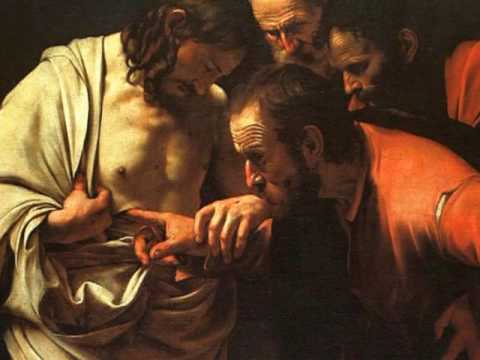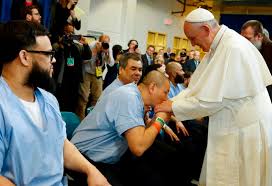Readings: Acts 2:42-47; 1 Pt 1:3-9; Jn 20:19-31
In the end, church happens where you touch the wounds. After participating in a couple spectacular liturgies at St. Matthew’s Cathedral for Good Friday and Easter Vigil, it was fitting that I ended up Easter evening in a much more modest fashion, hanging out with some friends from my parish choir, sharing life. My parish’s patron is St. Thomas the Apostle, whom we see in this week’s gospel famously “doubting” that Jesus had really appeared to the others. Thomas is often presented as someone whose faith is a little too weak, who needs “proof” and who gets a mild reproof from Jesus about how good it is to believe without seeing.
But maybe to believe the full promise of the resurrection, we all need to come into direct contact with the wounds of the cross. Let’s remember: Thomas has been through a lot. He’s like the others we see, whose hopes and dreams with Jesus seem to have been dashed by the crucifixion. It’s hard for us, on this side of Easter Sunday, to realize that Thomas is still in a fragile place. And we should also remember that the resurrection of one person in the middle of history wasn’t what anyone was anticipating. So when Thomas is reluctant to believe the word of his friends, maybe we can see him as someone who just doesn’t want to get excited again after having his hopes dashed. When he demands to see the wounds, he may be protecting and nursing his own pain at losing Jesus. It’s as if he is saying, “Look, I saw what happened to him. I saw what they did. Don’t give me any happy talk. If he’s alive, let me see those wounds.”
And besides, the uncertainty then allows Jesus to communicate something really important: the resurrection isn’t about making the wounds of the cross disappear. Yes, it is glorious, but Jesus still bears the wounds of his experience, and for Thomas to really know it is him, he must touch the wounds. This is something like what I think happens in genuine church community, which brings me back to my own community of St. Thomas. I’ve loved the parish for many reasons, but what makes it special is the community. When I first stumbled upon it ten years ago, the evening young adult mass had all the energy of a start-up led by a remarkable young priest (now, BTW, the rector of St. Mary of the Lake/Mundelein in Chicago) who not only had a gift for homilies that touched lives (and wounds!) but also an ability to empower whomever showed up to use their own gifts to build community. We needed that, for after he left, there wasn’t really a permanent replacement to pastor the community for years – yet the community held together, just because of the unexpected gifts that people kept on sharing with each other through thick and thin. Like the parish I came from in St. Paul, it wasn’t a church that just functioned as an administrative division or as an enterprise directed by paid staff. The church was the people keeping it together. We are blessed now to have more present pastoral leadership, but it is still the energy of the bonds formed that are the core.
And perhaps more importantly, in these days when we hear much about Benedict Options: it’s not a perfect place of perfect people, but a real place of real people. And that reality is most vivid, it seems to me, when we are just able to sit around and touch the wounds. By bringing our wounds into community, we unite them with Christ’s wounds – indeed, we meet and come to know Christ as our Savior because we are able to share those wounds in Him, in our Eucharistic community. The most beautiful liturgy in the whole world can’t make Christ present the way liturgy united with genuine community can. That’s what we see in the amazing portrait of the community in the Acts of the Apostles: the breaking of bread combines with the deep unity of sharing, symbolized by the community of possessions. And so, we are told, “They ate their meals with exultation and sincerity of heart.” We who share the Body become the Body… wounds and all. And out of that, new life comes.




